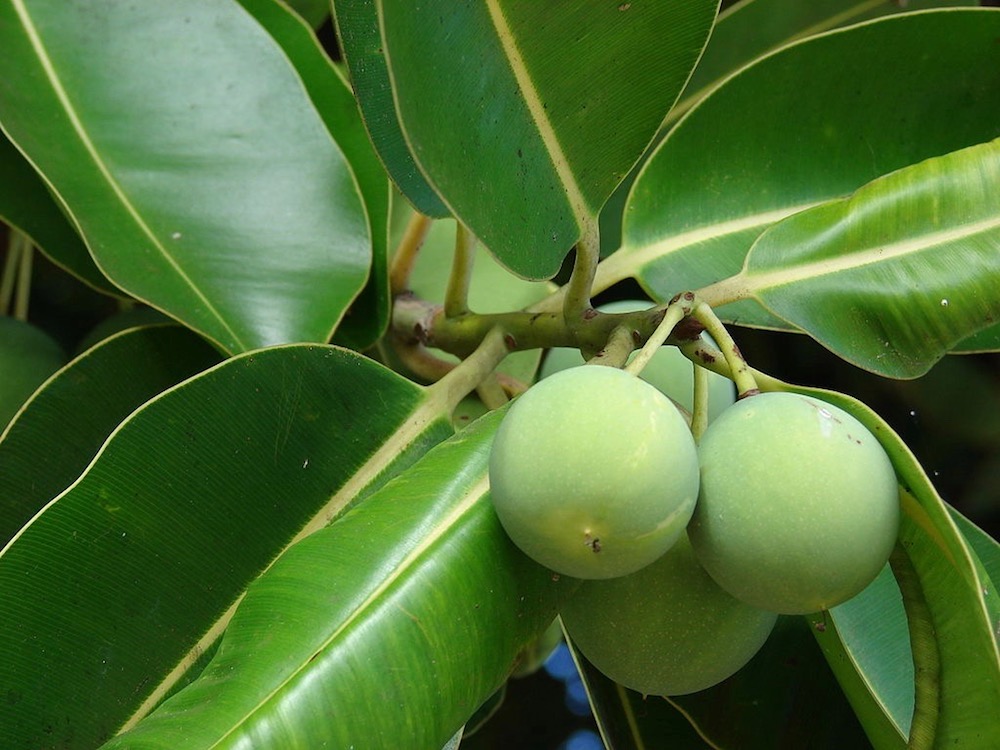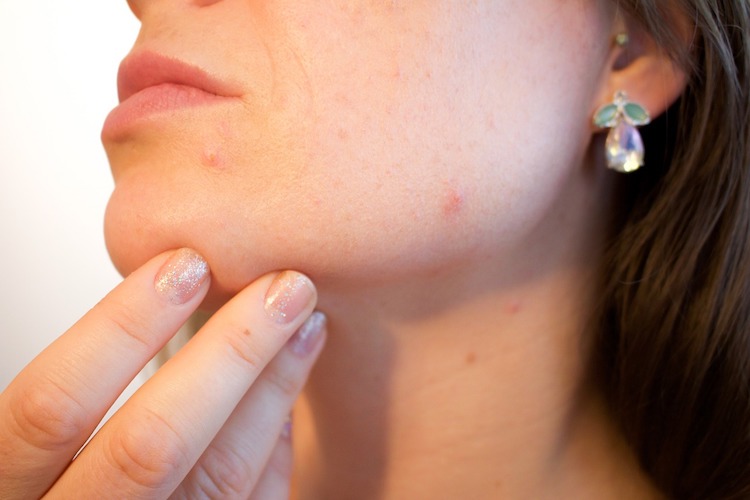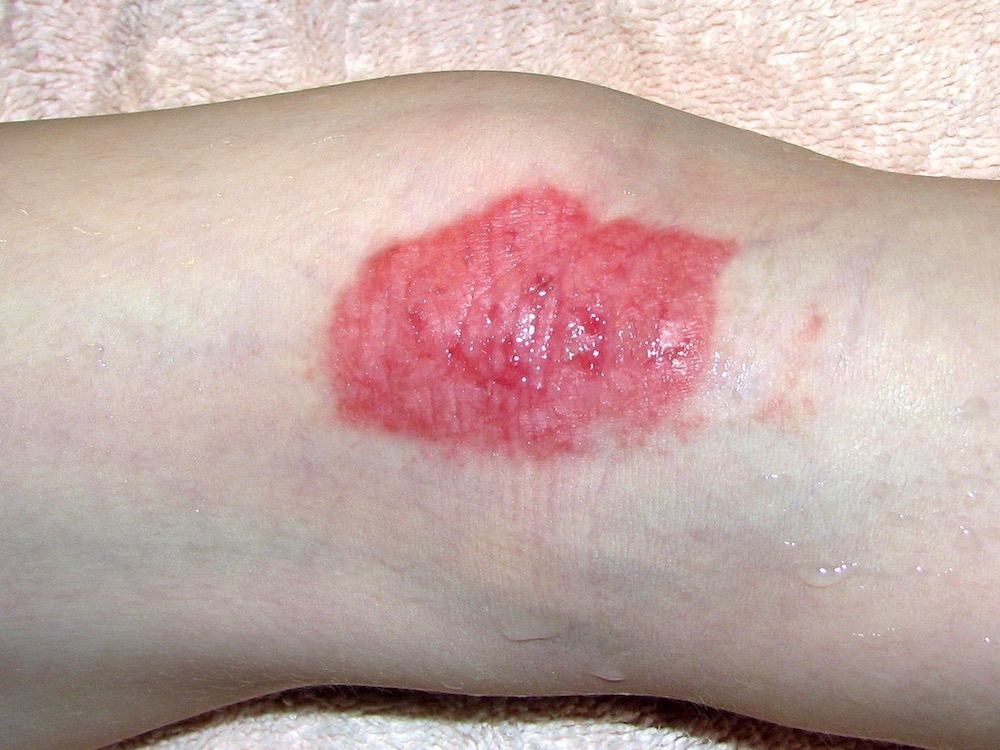
Tamanu oil comes primarily from the ati tree. Typical extraction comes via cold press from the tree’s seeds. The resulting liquid is slightly thicker than other plant-based oils and it has a dark green appearance.
While it can sometimes be used as a biodiesel fuel — yes, you read that correctly — it’s focus in the natural health market pertains to beauty and cosmetics. It also has a medicinal value related to the skin.
In the following article, we’ll be talking about the many benefits, the few side effects and considerations, and the ultimate reasons why you should keep this on-hand in your beauty cabinet.
But before we get into all that, let’s talk about what is in tamanu oil.
The Features of Tamanu Oil
Understanding why tamanu oil is so effective starts with understanding what is in it. While there are a variety of compounds in small quantities, here are the primary ingredients that make it so useful to the hair and skin care industries.
Linoleic Acid
What Is It? Linoleic acid is a polyunsaturated essential fatty acid. You will find it primarily in plant glycosides. As an essential, it is one of those “healthy fats” the body is incapable of producing on its own. It has to be obtained from an external source.
Tamanu oil is rich with linoleic acid, and while it isn’t used for all of these factors — more on what it is used for in a moment — linoleic acid itself helps create omega-3 fatty acids.
These can be helpful in fighting a number of diseases and conditions, including depression, anxiety, heart disease, and symptoms of ADHD. It’s also crucial to fighting inflammation and autoimmune diseases.
Oleic Acid
What Is It? This monounsaturated omega-9 fatty acid is found in both animal and vegetable fats and oils. Omega-9s have a reputation for being able to increase HDL — the so-called “good cholesterol” — while holding off triglycerides, blood pressure, and plaque in the arteries.
Palmitic Acid
What Is It? Palmitic acid can be obtained through a variety of sources including meat, milk, butter, and cheese. But the most commonly occurring source is palm oil and palm kernel oil.
While palmitic acid is a great source for skin care, it is more dangerous for human consumption as it tends to increase the levels of LDL or “bad cholesterol.” This is part of the reason you’ll want to stick with tamanu oil as a topical and not add it to any foods or beverages.
Calophyllic Acid
What Is It? Another fatty acid, this ingredient can be considered the “secret ingredient” of tamanu oil. Or rather, it’s the most unique. It acts as an antibacterial and anti-inflammatory oil. As a result, Calophyllic acid is highly useful as a skin care product. More on that in a bit.
Stearic Acid
What Is It? Stearic acid is an amino acid. It helps to lower surface tension in most oils. It also is a well-known cleansing agent that you’ll find in a variety of soaps and sanitizers.
Now that you know what makes tamanu oil unique, let’s look at the actual real-world applications.

Tamanu Oil Benefits and Uses
Most of the tamanu oil benefits and uses that you will encounter have to do with skin and hair care. It is not an oil that has digestive uses even though it contains the building blocks for many of the fatty acids that our body needs to adequately function.
But just because the benefits are confined to two specific areas of the body, that doesn’t mean there is a shortage of ways that it can improve your life. Here are 19, in particular.
1. Acne
Acne always hits at the worst times. Don’t believe us? Just think of the group it’s most likely to target. Teenagers. At a time when you are at your most self-conscious, that’s when you get hit with these unsightly, painful blemishes.
When you have a zit, no matter how small it actually is, it feels like it takes up your entire face and it’s the only thing anyone can seem to notice about you. Thankfully, tamanu oil is an effective topical agent for fighting back. How?
Remember when we spoke of Calophyllic acid? This is found abundantly in tamanu oil. It’s also the most active ingredient for fending off Staphylococcus aureus, which is the bacteria that contributes to acne.
2. Stretch Marks
Stretch marks, or striae distensae because the medical community always has to be difficult, affect between 50-90 percent of the population. We know that’s a broad range, but either way, it translates to hundreds of millions domestically and billions worldwide.
According to Virtual Medical Centre, the primary risk factors are “closely related to hormonal and physical factors.” Pregnancy, prolonged steroid use, and obesity are among the major culprits. So how does tamanu oil make a difference?
Once again, as a topical agent containing essential fatty acids for skin elasticity and permeability, tamanu oil is able to fill out a significant portion of the “dimpling” effect caused by stretch marks. In so doing, it can help you feel more comfortable with your appearance, especially during those times of the year where it’s more common to shed clothing. (Looking at you, summertime.)
3. Razor Burn
Men and women don’t always see the world in the same way. But there is one problem both have to deal with in equal measures. Razor burn. Men who shave everyday experience this quite a bit, but considering women typically shave more surface area — legs, armpits, etc. — they feel the pain as well.
Razor burn manifests as small dark or reddish bumps that congregate around hair follicles. As a result, inflammation occurs in the surrounding skin. Cosmetically, it’s distracting. And it can increase the sensitivity of the face and make it more prone to bleeding with the next shave.
Tamanu oil applied to the affected area can reduce some of the swelling and inflammation thanks to the Calophyllic acid component.
4. Ingrown Hairs
These are no picnic. They’re usually brought on by “shaved or tweezed hair (that) grows back into the skin,” according to the Mayo Clinic. Waxing also can make you susceptible.
Anyone with curly or coarse hair knows all too well the painful effects of an ingrown hair. While the condition usually goes away on its own, that can be an especially painful waiting period. And there have been cases where a small incision is necessary to relieve some of the pain and swelling.
Growing your hair long is a good remedy. But if you just aren’t ready to sign on for a few days of pain, you can apply a few drops of tamanu oil to the affected area to help take down some of the swellings.
5. Scarring
Few people are fortunate enough to get through life without experiencing some type of trauma to their skin. It could come in the form of a cut, gash, burn, or surgical incision.
While most scars are lifelong commitments, the ability to reduce their visibility is up to you. For deeper scars, and this may seem counterintuitive, you’ll need to consider a surgical treatment, and you may find that taking such a drastic and costly measure isn’t worth it. (Especially if insurance won’t cover it.)
Tamanu oil can function as a natural treatment option when applied topically, thanks mainly to the Calophyllic acid content.
6. Poison Ivy
When used as the primary blend along with other essential oils, tamanu oil is effective at taking the heat and swelling out of the rash that accompanies a poison ivy infection.
Some suggestions for essential oils to use in conjunction with tamanu oil include the following:
- Rosemary
- Lavender
- Peppermint
- Tea tree
It should be noted that if you’re not a big fan of putting stuff on your skin, the rash will go away on its own after 5-12 days. Some, however, have lasted as long as a month. In that case, you may want to seek a doctor.
7. Dry Skin
When going through the pains and annoyances of acne, dry skin might not seem such a bad deal. After all, acne is caused, in part, by oil overproduction leading to clogged pores. Dry skin occurs when your skin is producing little or no oil to a given area of skin.
But with dry skin, you may find yourself clawing away like a madman or woman in an effort to get some relief. The older you get, you know exactly what we’re talking about. That’s when the body’s oil production slows down permanently.
A few drops of tamanu oil — either on its own or as part of a blend — will rehydrate the skin for hours and provide relief to the flaking and itching that can make this condition unbearable.

Tamanu Oil can help when applied topically.
8. Rosacea
For all that we know about how rosacea looks and how many people it affects, we don’t know that much about what causes it. Some dermatologists attribute the cause to blood vessel abnormalities, particularly in the facial region where flushing and redness common to the condition is likely to occur.
The problem has proliferated over the last several years, both domestically (where an estimated 16 million are affected) and worldwide (415 million), according to April 2018 numbers from the National Rosacea Society.
Tamanu oil is no cure for rosacea, but it can help dial back some of the inflammation, attacking the flushing symptom before it gets worse.
9. Arthritis
As a natural anti-inflammatory, tamanu oil could be beneficial for symptoms of arthritis. As anyone who suffers from this condition knows, it manifests in the form of inflammation around the joints.
It can result in joint pain and considering the body has 360 joints, it can greatly affect one’s quality of life if it spreads unchecked.
Typically, arthritis affects isolated regions of the body and is not widespread. But sufferers of RA, or rheumatoid arthritis, can experience it in several regions at once.
And research shows that the more severe arthritis is, the more likely other conditions such as obesity, diabetes, and heart disease are to develop. That’s because it zaps your desire to do anything healthy.
10. Abrasions
Abrasions are different from scarring, stretch marks, or cuts. An abrasion can occur in an area of the body that has experienced deep scrapes or skin damage. They’re usually temporary, but areas with recurring abrasions — think areas where the skin is brittle or dry — can become more permanent fixtures.
Tamanu oil topical treatment to help rehydrate and de-flame the skin can promote the healing necessary to get rid of abrasions once and for all.
11. Psoriasis
Psoriasis isn’t a life-threatening condition but it is an incurable one. The cause of psoriasis, as with rosacea, is not entirely known. But we do know infections, stress, and cold are the most common triggers.
It typically shows up as a skin rash. In less common manifestations, it can affect nails and joints, making it even more difficult to get relief once the symptoms flare. A topical ointment like tamanu oil can slow the growth of rash “scales” and reduce inflammation.
12. Eczema
Yet another skin condition that brings with it a rash. Joy. This one attacks the bends in areas of skin such as the inner elbows or the backs of the knees. Small children usually have to deal with it more than adults.
But it can follow you into adulthood, so don’t get cocky if you make it through your early years untouched.
Eczema’s effects can be exacerbated by soaps, lotions, and other irritants. If you notice an outbreak, make sure you’re monitoring the cleansing agents you’re using.
Also, consider switching to soaps that contain tamanu oil, as it has an anti-inflammatory effect on the skin thanks to the Calophyllic acid.
13. Eye Serum
First off, let’s read and acknowledge the fine print. This is what we mean by “eye serum.” It should not — in any way, shape, or form — be used as an eye drop. This is not for internal use. Period.
The application here is for folks who experience a lot of wrinkling, or “baggage,” under the eyes. Tamanu oil’s natural ingredients that make it a spectacular skin care agent can “plump” the skin out a bit and promote elasticity to smooth out those wrinkles in a hurry.
For an eye serum that works particularly well, we recommend checking out this one from Minimalist Beauty.
14. Wrinkles
Don’t just stop with the eyes. The aging process makes several regions of the face subject to a loss of elasticity. Applying to cheeks, forehead, and browline could beat back some of the other crevices that often occur the older we get.
It does this, in part, by regenerating skin cell growth and expanding the elasticity of existing cells.
Many over-the-counter skin care products use tamanu oil, or at least some of its core ingredients, in their final “profile.”
15. Wound Healing
Again, tamanu oil’s ability to regenerate skin cell growth allows it to act as a “bridge” for regions of the body that have experienced traumatic injury, particularly wounds.
It also acts as an antibacterial agent, thus fighting off infection, triggering the immune system, and allowing the region to organically heal.
It probably goes without saying, but don’t rely solely on tamanu oil for this function. First, seek emergency medical treatment, especially for wounds of a more severe variety.
Also, talk to your doctor about the safety involved. In the side effects and considerations section, we’ll get into the reason why in a little more detail.
16. Sun Damage
While we’re on the topic of wrinkles and aging, you know what causes the vast majority of it? Our good friend, the sun. Yes, it gives and sustains life, but the everyday wear-and-tear also results in premature aging and wrinkles through a gradual withering away of skin cells.
If you are particularly sensitive to UV light or you spend a lot of time in the sun living or working, then you need to take proactive measures to keep it from breaking down.
Tamanu oil’s ability to replace skin cells and improve elasticity serves to reverse some of those effects. Furthermore, its promotion of healthy skin cells can create an environment less tolerant for the growth of certain skin cancers.
17. Fungal Infections
According to a 2017 study published in the Journal of Fungi, fungal infections affect more than one billion people worldwide each year, and they are responsible for the deaths of an estimated 1.5 million.
Tamanu oil has unique anti-fungal properties when applied as a topical agent that can help protect the skin from growth and prevent manifestation.
You will still want to check with your doctor when the infection occurs to ensure you’re taking the appropriate medications for killing the infection. But as an ongoing at-home treatment, tamanu oil is capable of staving off symptoms and improving your quality of life.
18. Hair Care
Much of this section has been devoted to the ability of tamanu oil to fight rashes, infections, and the everyday effects of skin aging. However, we would be remiss to end this section without first talking about the hair care benefits that it brings to the table.
Referring back to the Features section at the top of this article, one of the primary ingredients of tamanu oil is its dosage of stearic acid. This particular amino acid is used in a variety of cleansing agents, and it’s the perfect ingredient for dislodging dirt and oils from the hair.
This makes for a stronger, fortified follicle that promotes healthier and more lustrous hair. That’s why you’ll find at least pieces of tamanu oil in many of the most popular shampoos and conditioners.
19. Cleaning Agent
The stearic acid content that makes tamanu oil such a great hair care product also makes it beneficial in soaps and facial cleansers. It’s particularly effective at dislodging microscopic dirt and bacteria that would otherwise go unnoticed. It also mixes well with other oils and fragrances.

Allergic reactions are possible with tamanu oil. Make sure you do a skin test first.
Possible Side Effects and Considerations
Despite its numerous benefits to skin and hair, there are some drawbacks that you will need to be mindful of before you decide to incorporate tamanu oil into your ongoing routines. They are as follows:
- Allergic Reaction: anything that occurs in nature comes with a built-in possibility that you might have an allergy to it. Before deciding to use tamanu oil, test out a small amount on your skin. You can try it on your own, but we recommend consulting with a dermatologist first. If you notice redness or swelling as a result of the application, cease use of the oil immediately. Also, make sure you avoid skin and hair care products that feature tamanu oil in their chemistry.
- Pregnant or Nursing Women: always a good idea to consult with an OBGYN before using a natural oil or oil-based product when pregnant or nursing. That’s because the substance can be absorbed and passed along to the baby. To avoid any potential adverse effects, just lay off use until the pregnancy and nursing period is over.
- Storage Time: all oils have an expiration date and tamanu oil is no exception. When using this substance, it’s important to be aware of the age of the formulation. Typically, tamanu oil lasts about two years. After that period of time, like others, it can go rancid and have adverse effects if absorbed into the skin.
Use of tamanu oil is generally safe, so these are just issues to be aware of.
Consider Adding Tamanu Oil Today
If you have never tried using tamanu oil in your everyday beauty and skincare routines, consider starting small by applying a few drops to areas that aren’t as visible. Doing so will guard against potential allergic reactions being visible to the public.
Once you know you’re not allergic, pregnant, or nursing, you can amp up use. Just make sure you stick with it as a topical solution, whether applied through drops or through soaps, shampoos, or conditioners that feature it.
Tamanu oil carries many benefits under standard conditions, and we can’t wait to hear about your experiences using it. Share your thoughts on this natural aging solution in the comments section below.



Tamanu oil is best remedy for many common skin problems. I have used it and it has amazing anti aging property. I like this article so much. Thanks and keep sharing.